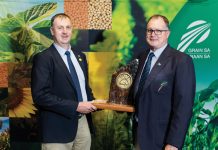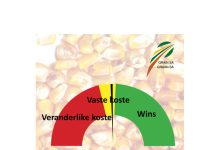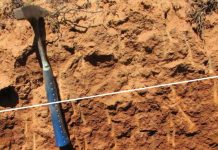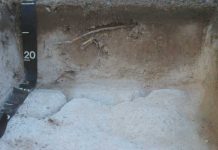Soil is the most fundamental resource for the farmer, without which food and natural fibre cannot be produced. This article forms part of a series to highlight this resource.
Organic material only makes up a small fraction of the soil and in the majority of the grain areas in South Africa, this fraction is exceptionally small (<1%). This article attempts to place in perspective the effect of organic material on the physical properties of soil in South Africa.
Levels of organic material
Compared with the levels of organic humus in the wetter cropping areas of the world, the humus levels of the typical arable land in South Africa are significantly lower. In world terms one would comfortably talk of organic carbon levels of 1% or 2% and as much as 10%.
In South Africa one seldom finds 1% and in most cases less than 0,5%. The typical natural organic carbon levels of the arable land in the Free State, North West Province and Mpumalanga are 0,1% to 0,5%. In the majority of cases it represents less than 50% of the original (untilled) levels. Furthermore, the conditions for the breaking down and mineralisation of organic material in soil are very favourable because the largest parts of South Africa have a semi-arid climate, summer rainfall and warm summers.
The dry semi-arid climate restricts the growth of plants and therefore the production of organic material (compare South Africa’s 2 ton/ha – 4 ton/ha maize production levels with the >8 ton/ha of the large maize regions in the USA). This also then explains the relatively low levels according to which the supplementation and breaking down of organic materials in South Africa reach equilibrium. In the wetter and cooler eastern areas in the country, one often finds higher humus levels. The effect of higher organic material levels, mentioned in textbooks, must be interpreted and applied with caution in South Africa.
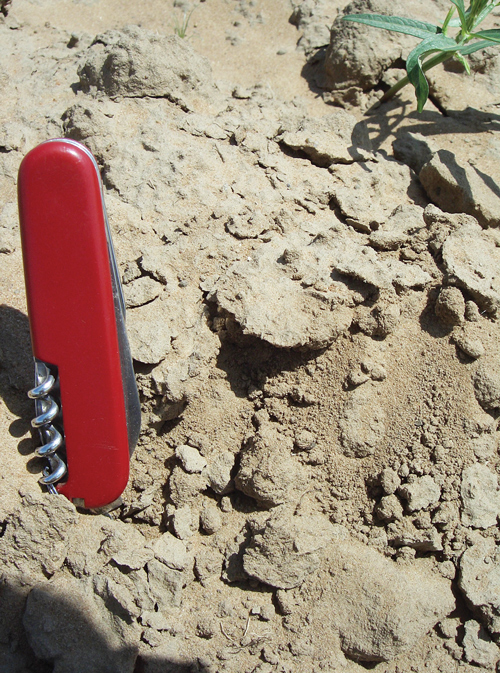
Effect of organic material on physical properties of soil
The science of organic material in soil was discussed in greater detail in the previous two articles. Consequently, this article focusses more on the effect of organic material on the physical properties of soil that apply to South African conditions.
Structure
Soil structure refers to the natural aggregation (binding together) of individual soil particles to form larger secondary aggregates or clods. In clayey soils, the swelling and shrinking properties of the soil play a major role in forming aggregates and therefore clayey soils often have a crumbly or blocky structure. In apedal (structureless) soils, which are mainly sandy, these swelling and shrinking properties barely exist or do not exist at all and the soil particles are separate to each other (sea sand, for example). Sandy soil is therefore typically susceptible to wind erosion and sometimes also water erosion.
The presence of organic material in soil serves as a source of nutrition for the micro-organisms and other larger invertebrates such as earthworms. Some bacteria emit polysaccharides (long chain sugars) as a kind of water insoluble gum cocoon in which they live. This polysaccharide sticks together a collection of soil particles into a small stable clod (micro-aggregate). This micro-aggregate is now water stable and too heavy to be blown away by wind and, as such, effectively controls wind erosion. Fungi play a similar role because the hypha bind the soil particles together.
The other side of the coin is the degradation of organic material and structure in the soil. The greatest cause of this are soil tillage systems in which soil is turned over and aerated so that the earth “lies beautifully red”. Soil with few microbes and micro-aggregates now lies on top. The effect of this is that the organic material is worked into the aerated soil – thus excellent conditions for the soil microbes to mineralise this excess organic material rapidly (to break down into basic plant nutrient substances).
Land users are aware of the fact that, for the first few years after the soil has been ploughed for the first time (virgin soils), the soil is very productive. As the organic material is mineralised and thus degrades, a point is reached where the release of mineral nutritional substances from the organic material is no longer enough to support crops productively. Together with this comes structure degradation. After a shower of rain, sandy soils in particular are dispersed (inadequate polysaccharides) and a crust forms on the soil surface. The soil is now extremely exposed to wind and water erosion. To eliminate this detrimental effect, the soil is now ploughed while wet so that temporary structure is formed through the mechanical action. These circumstances are now favourable for further formation of soil degradation, namely compaction.
The management of structure formation in sandy and other soils entails regular addition of organic material. The ideal is that the organic material is left to lie on top of the soil so that, in time, it can build up an enriched layer, shallow in the topsoil and on top of the soil. Microbes then help with the formation of micro-structure units in the upper 2 cm – 3 cm of the soil. Soil particles are stuck together and bound by hypha. The effect of the hypha may sometimes be seen with the naked eye when the uppermost crust is carefully lifted. One can then see grains of sand and micro-aggregates swinging around on the hypha. When the soil is tilled again (especially ploughed), all these benefits are destroyed. This therefore implies that the practice of spreading organic fertilisers such as cattle or poultry dung and then ploughing it in so as to form a structure to reduce wind erosion, carries little value. (It has been said that a single tillage is sufficient to destroy four years of organic material accumulation!)
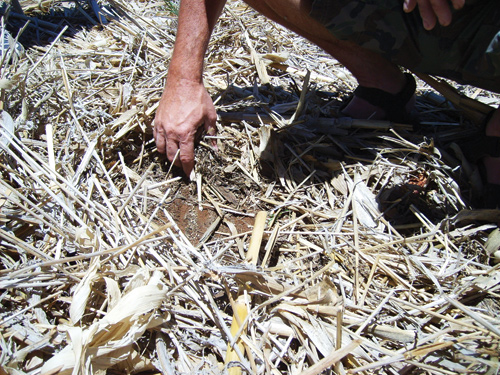
Water infiltration
Water infiltration is defined as the movement of water through the soil surface into the soil, so that the water no longer lies on top of the soil surface or runs off. The addition of organic material to promote water infiltration is particularly significant and effective: soil with inadequate upper level structure disperses when rain falls on it. The small pores through which the water must infiltrate the soil, are blocked by clay and silt in suspension. The result of this is that the water runs off and is lost to crop production.
The other side of the coin here, is as follows: soil with a stable surface structure has more and larger pores for water to infiltrate through. The aggregates are also stable and the pores are not blocked by clay or silt in suspension. A sign of this is that run-off water from the land is clean and not at all muddy. Also, a layer of plant waste on the land slows down water run-off, which offers the water greater opportunity to infiltrate. The practice of leaving organic material on top of the soil year after year in order to promote water infiltration has a sound agricultural foundation.
South African conditions are important in determining the quantities of plant material. To broadly spread 0,5 ton/ha or 1 ton/ha of organic material on the land and then plough it in, will not make any significant difference to water infiltration. About 4 ton/ha or more, which is left to lie on top of the soil will only begin to make a difference, especially if done for two or three consecutive years.
Water retention ability
The water holding capacity of soil rich in humus is better than soil with low humus levels. The effect of this is insignificantly small because the organic material content of South African arable land is relatively low. The difference in the water retention ability between soil with 0,2% and 0,4% organic carbon, is so small that there is no difference for the soil user. That also represents a thin layer of soil at the soil surface and therefore a small percentage of the soil profile.
Drainage
Drainage refers to the property of certain soil types to allow excess water to move through the soil profile and below the rooting sone. Such soil is described as a well-drained soil. An example of this is deep sandy soil. This property is mainly an inherent soil property and can only be improved at great cost with a drainage system. Organic material can do nothing to change this. Organic material can at best improve the structure of the profile so that water will move more rapidly through an already well-drained profile.
Evaporation
The effect of plant residues on top of the soil is that the soil is shaded, thus lowering the soil temperature. This results in there being less energy available to convert the water to vapour. It also reduces the amount of air movement directly over the soil surface which retains the evaporated water vapour in the soil, thus lowering the vapour pressure gradient and, in the process, also the evaporation. A layer of plant residues on top of the soil therefore extends the tempo of water loss. So, for example, a covered profile under a given set of climatic conditions could take five days to dry out to a depth of 100 mm, while the uncovered profile may dry out within two days.
The principle is, both pieces of ground are dried out and after both have dried out to a depth of 100 mm, further drying out is a function of capillary supplementation from the deeper soil layers, which is a much slower process (much slower than the rate of evaporation). Thereafter, both pieces of ground will dry out to the same extent – with or without plant waste. There is an evaporative benefit for the soil with the plant residues when it rains a bit every day. That is because the bare soil allows more water to evaporate every day before the next supplementation and cumulatively it could make a difference of a couple of millimetres of water. The question is, however, whether the annual evaporation losses under South African semi-arid conditions, are significant with or without harvest waste, given the average crop yields achieved? It is probably so little that the soil user would not notice the difference in terms of an increased grain yield. At planting time it does, however, make a difference because the planting conditions under a cover remain favourable for a day or two longer.
Soil temperature
As mentioned above, plant residues provides shade for the soil and less solar energy reaches the soil, which lowers the soil temperature. Because organic material promotes structure formation, it will also lower heat conductivity. This is because there is less contact between soil particles, as the soil structure is less solid. On the other hand, humus makes the soil colour darker which will potentially absorb more solar energy, but if it is covered with plant residues, the soil will be cooler, despite the darker colour.
Summary
Upon close inspection, the addition of organic material to soil has a number of advantages for the South African agriculturist in terms of the physical properties of soil. Of these, increased water infiltration and the combatting of wind and water erosion are the advantages with the greatest impact. In fact it is the most effective and sustainable way in which to protect soil against erosion. The limitation of evaporative losses and management of soil temperature, are secondary advantages.
For further information, please contact the authors on:
Martiens du Plessis: 072 285 5414 / martiens@nwk.co.za
Prof Cornie van Huyssteen: 051 401 9247 / vanhuyssteencw@ufs.ac.za
REFERENCES
- Brady, NC. 1990. The nature and properties of soils. 10th ed. Macmillan publishing company: New York.
Land type survey staff. 2007. Land types of South Africa. ARC Institute for Soil, Climate and Water: Pretoria.
Van der Watt, HvH, van Rooyen, Theo H. 1990. A glossary of Soil Science. Soil Science Society of South Africa: Pretoria.




